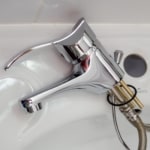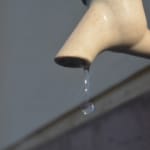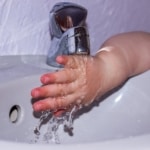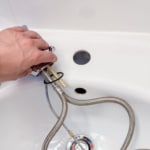In Which Direction Do I Turn the Tap to Open and Close It?
If you open a tap, the water comes out. Every child knows that.
But what about taps where you cannot see this straight away – on washing machines, for example?
When are these open and closed?
Do you have to close them at all?
Should you turn off the water in your apartment before going on vacation?
And what about the tap in the garden during winter?
We will tell you everything you always wanted to know about opening and closing your taps.
Contents
In which direction do I turn the tap to open and close it?
Just like with screws and bottle caps, the following applies: water taps are closed turning them clockwise and opened counterclockwise.
To remember this, you can use the following mnemonics:
- Alphabetical order: “(turn) left (to) open, (turn) right (to) shut”
- “Left like loose” / “loosening: left”
- “lefty loosey, righty tighty”
- Write a small “o” (for “open”) in cursive. Turn the tap in this same direction.
This question seems just as simple: When is the tap closed?
If no more water comes out, one would think. However, older fittings in particular tend to still drip after they are turned off.
In this case, you may need a little more force to turn off the water. But caution is advised here, because the old plumber’s rule still applies “after it is tight it will come off.”
It is better to remove limescale from the tap or to replace it, instead of damaging it by turning it too tightly. In the worst case, you will flood the entire bathroom.
In which direction do I open the tap on the washing machine?
For your washing machine to work, it surely needs one thing: water.
There is usually a ball tap at the water connection that must be opened before the washing can start.
The following also applies here: open counterclockwise, close clockwise.
How much should I open the tap for the washing machine?
How much you open the tap for the washing machine is not critical for its safe operation.
But remember: the more you open the tap, the faster the machine will fill with water, which will reduce the time the washing cycle takes.
Incidentally, you can achieve the highest flow rate by opening the tap all the way and then closing it a bit by doing half a turn to the left.
This guarantees the mobility of the tap in the long term, as it is less prone to wedging.
Users that retrofitted Aquastop features with a mechanical design to their installation should be careful. When using the washing machine with Aquastop for the first time, we recommend opening the tap slowly.
This way the hose does not fill up too quickly with water and the pressure increase is limited. For the following wash cycles, you can then open the tap as quickly or slowly as you want.
Once the washing cycle has started, keep your fingers off the tap. Even if no water is flowing through the hose momentarily, the washing machine can still draw water later.
You don’t have to worry that too much water would run into the machine. Today’s devices regulate the amount automatically.
What to do if you cannot open the tap for the washing machine?
If the red water tap indicator on the washing machine lights up, this indicates that the water supply is insufficient.
This may be due to a defect in the device but can also be due to the tap not opening far enough.
The following solutions have proven effective:
1. Rule out a defect in the device
To rule out the tap as a source of error, you can use the following trick:
- Disconnect the washing machine from the power supply.
- Close the tap and remove the hose from the washing machine.
- Put a bucket under the tap and pick up a stopwatch.
- Open the tap all the way and let it run for 1 minute. Then measure the amount of water.
If this is less than 10 liters (the easiest way to measure it is with a scale), the flow rate of the tap is too low, and you should take the next step:
2. Remove valve
Limescale and dirt can build up on the valve, especially if the tap is not used much.
Over time, these lead to the tap no longer opening far enough.
To check the valve, do the following:
- Shut off the water supply via the main shut-off valve.
- Remove the handle of the valve. You may have to loosen a screw that is located under the blue cap. The handle can then be taken off.
- Unscrew the valve insert with a suitable wrench.
- Now examine the valve insert. This has a spring that tends to get stuck when calcified.
If the spring is difficult to move, the following approaches are recommended:
Cleaning of the valve
If the calcification is not too severe, you can try cleaning the valve insert. So, the spring will be movable again.
Place the insert in a solution of 1/3 vinegar essence and 2/3 water. Let it sit for a few hours and then rinse the valve with clear water.
Finally, you should lubricate the moving parts of the valve insert with some valve grease before screwing it back in.
Purchase of a new part and exchange
If the calcification is very advanced, cleaning is hardly worthwhile. Fortunately, valve inserts are available in hardware stores for around 5 euros.
Of course, you can also equip the washing machine with a new tap.
We recommend so-called device connection valves, which are fairly inexpensive, depending on the number of devices that can be connected.
Installation is very easy, as the valve is simply screwed into the pipe section on the wall.
The only thing that has to be done beforehand with (non-self-sealing) valves is roughening and sealing the thread. Instructions how to do this can be found here.
Should I close the tap on the washing machine?
Once the washing machine has done its job, the question arises: does the tap have to be closed or can it remain open?
An important topic, after all, as you may forget about this in the hectic everyday life.
To answer this question, you must distinguish: does the washing machine have an Aquastop function or not?
The name Aquastop refers to various protection systems that are intended to prevent water from running into the machine in an uncontrolled manner when it is not in operation.
Should a defect occur or a hose burst, the water supply is automatically interrupted.
If you use a washing machine with Aquastop, you can, from a legal point of view, leave the tap open.
If damage occurs despite Aquastop, it is not your fault. This is how the German Federal Court of Justice ruled in 1985.
Of course, there is nothing wrong with shutting off the water supply when the washing is finished even with such machines.
Especially if the washing machine has caused problems in the past, you shouldn’t take any chances.
If there is no Aquastop protection device, you are acting with gross negligence if you leave the tap open after washing.
Such is the ruling by the Oldenburg Higher Regional Court.
This means that the hose is permanently under pressure and can become porous. In the event of damage, you would have to bear a considerable part of the costs yourself.
Therefore: Closing the tap after using the washing machine is always a good idea.
However, it is absolutely recommended for machines without Aquastop.
In addition, you ensure the tap’s mobility by turning it regularly – which is essential if you want to connect a new device.
How can I close the main shut-off valve?
Today’s households have a network of pipes that supply fittings and machines with water.
They are all controlled from a central point: the main shut-off valve. If you close it, the supply for the entire house is interrupted.
As important as this main shut-off valve is: Most of the time it ekes out a relatively unnoticed existence.
But at the latest when it is time to replace any fittings, you will need it. So, you should know what it looks like and where to find it.
If you reside in a house, you have to go to the basement – in most cases. Follow the pipes until you come to the water meter that shows your consumption.
You should now see two taps: one before and one after the water meter. The water supplier is solely responsible for the tap before the water meter – e.g. when the meter needs to be replaced.
The main shut-off valve is located after the water meter. It is opened by turning it to the left, closed by turning it to the right.
As I said, this tap ekes out a shadowy existence and is not used very often. So, when the time comes and you happen to have to move it, it may already be stuck.
That is annoying when the plumber comes to carry out repairs, because without the water turned off, he cannot do anything.
So, as a smart homeowner, here’s what you do: once a month, go to the main shut-off valve, close it, and open it again.
In this way, you can ensure that everything will continue to work as it should in the future.
By the way: As a tenant, you may not have your own shut-off valve. In this case, you must ask your landlord to turn off the water for your apartment via the house’s shut-off valve.
When should I close the main shut-off valve?
In normal everyday life, of course, the main shut-off valve must remain open. Otherwise you will be sitting on dry land in no time.
However, if you leave the house for a longer period of time, for example on vacation, you should close the main shut-off valve.
In this way you will avoid having water damage when you are unfortunate enough for a pipe to start leaking while you are away.
After you have closed the main shut-off valve, you should still do the following: Open all the fittings in the house to allow any residual water to drain from the pipes.
If the water is in the pipes for too long, harmful bacteria, so-called legionella, can form.
When you’re back from vacation, it’s best to fully open all the taps. In this way, the lines are properly flushed and any bacteria that may be present are washed away.
When should I close the outside tap?
Taps on the outside of your house are handy for connecting garden hoses. At the latest when the first frost occurs and the end of the gardening season is approaching, you should close any outside taps.
In addition, the following steps are recommended to avoid damage from frozen water pipes:
- Close the shut-off valve for the outside line by turning the handle to the right. The valve is usually located in the basement.
- Open the outside tap to allow any remaining water to drain.
- Now look for the drain valve next to or under the shut-off valve. Hold a bucket under the valve and open the valve to drain the last water remaining.
- Close the drain valve and the outside tap. Your water pipe is now ready for the cold season.
By the way: If you live in a newer house with a self-draining external tap, you do not have to worry about draining the pipe. In this case, it works automatically.
Sharing is caring 🙂 !
[addtoany]




